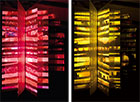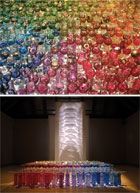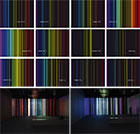
|
Eugènia Balcells opened the Laboratori d’Arts Santa Mònica (Arts Santa Monica Laboratory) on the 23rd of September 2009. The exhibition project “Frequencies”metabolised for the first time the DNA of the top story of the convent at the end of the well known Rambles in Barcelona. Seen from the distance, I doubt there would have been a better choice for a first exhibition in this new area for scientific knowledge and experience through art. Balcells project, commissioned by Eulàlia Bosch, dealt with all the aspects that the laboratory intended to develop and offered a wide range of possibilities in the pre-project conceived together with Vicenç Altaió with an agreement with the UB (Universitat de Barcelona) We could speak of the great value of her artistic career, which developed in New York during the 1970’s inside the context of the conceptual art movement, the audiovisual and the installation art, or merely through the then new relationship with new technologies. Here is where we should talk of the connection Balcells has with science. Their connection is often subtle, as shown in exhibitions like “To See the Light” at the MACBA (Museum of Contemporary Arts of Barcelona) in 1996, an exhibition commissioned, by the way, by the pioneer educational service launched by Eulàlia Bosch. And also, as I myself was able to sense in my conversations with the artist in 2006. Her eyes oozed enthusiasm while talking of Fritjof Capra and “The Web of Life”, or of the great mysteries hidden behind the crystalline phases of water, an essential molecule but whose complexity is still today unmanageable. From this perspective, “Frequencies” as whole refers to the crystallisation of alternative science which is solidified in most science museums. Light, once more, was a main theme, but, this time, getting closer to the carnality of science. On the one hand, “Colour Wheel” showed the whole cosmos at once. A film of never-ending lines classified according to the seven colours proposed by Newton. The grandiosity of the piece relied on the effort of accumulating motion images of the cosmos. The artist, who studied to be an architect, added a light monumentality with a silken paddle wheel. Somehow, this device reverses Newton’s work. If a prism breaks the unity of light to display different colours, the silk structure holographically lifts the cosmos from thousands of films classified according their tonality. Still today, some remember that the space of the exhibition became thus a learning space. The “Merce Cunnigham Dance Company” revealed part of her methodology constructing the complexity of the choreographic movement through simple behaviour rules. The movement of the dancers was followed by a dance similar to the relationship between light and matter according to quantum physics principles. Temperature excites one atom and the atom responds with a vibration releasing photons, which at the same time collect other atoms and the exchange goes on, ad infinitum, following the “Colour Wheel” rhythm. The light of an element from the periodic table has a collection of Hertzian frequencies, a bar code that decrypts the identity of the observed matter. “Frequencies” was the title of the whole project, but it was also an artistic installation, a door to the exhibition. Visitors would go through a luminous sea of atomic spectra of the elements on the periodic table. Thus, Eugènia honours the elements of Medeléiev’s table, the material essence we are made of. Another path of the exhibition showed a gigantic periodic table. Every space on the grid was assigned to an element together with the information of this element, but the background was not orangey or yellowish, as they usually are in periodic tables. The backgrounds showed atomic spectral lines with their colours. A crossed view allowed a glimpse of a certain invisible global structure between the chemists’ orange periodic table and the physicists’ spectral lines. The two disciplines converged. The exhibition closed down on the 29th of November 2010 with many people visiting –really early. The affluence of educational centres was very significant, which, after the visit, initiated academic projects linked to their experience there. More than a year later, the “Frequencies” project has never left us. I often ask why to Eulàlia Bosch. And she replies: “Eugènia is like that…” I will never be thankful enough for having shared this intense experience at Arts Santa Monica. Josep Perelló. Professor at the Department of Fundamental Physics at the UB (Universitat de Barcelona). |
|
|
Issue 69 (2011): Elective Affinities |
||||
{rokbox album=|3152| text=| |}images/stories/MetodArt/Eugenia_Balcells/RodaColor_b.jpg{/rokbox} |}images/stories/MetodArt/Eugenia_Balcells/RodaColor_b.jpg{/rokbox} |
{rokbox album=|3152| text=| |}images/stories/MetodArt/Eugenia_Balcells/Brindis_b.jpg{/rokbox} |}images/stories/MetodArt/Eugenia_Balcells/Brindis_b.jpg{/rokbox} |
{rokbox album=|3152| text=| |}images/stories/MetodArt/Eugenia_Balcells/Frequencies_b.jpg{/rokbox} |}images/stories/MetodArt/Eugenia_Balcells/Frequencies_b.jpg{/rokbox} |
||
| Eugènia Balcells. Roda de color, 2009. Instal·lació multimèdia. |
Eugènia Balcells. Brindis (invitació a l’abundància), 1999. Instal·lació multimèdia. |
Eugènia Balcells. Freqüències, 2009. Instal·lació multimèdia. |
||





